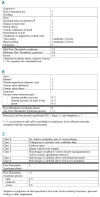Post-thrombotic syndrome in children: a systematic review of frequency of occurrence, validity of outcome measures, and prognostic factors
- PMID: 20595095
- PMCID: PMC2966919
- DOI: 10.3324/haematol.2010.026989
Post-thrombotic syndrome in children: a systematic review of frequency of occurrence, validity of outcome measures, and prognostic factors
Abstract
Background: Post-thrombotic syndrome is a manifestation of chronic venous insufficiency following deep venous thrombosis. This systematic review was conducted to critically evaluate pediatric evidence on frequency of occurrence, validity of outcome measures, and prognostic indicators of post-thrombotic syndrome.
Design and methods: A comprehensive literature search of original reports revealed 19 eligible studies, totaling 977 patients with upper/lower extremity deep venous thrombosis. Calculated weighted mean frequency of post-thrombotic syndrome was 26% (95% confidence interval: 23-28%) overall, and differed significantly by prospective/non-prospective analysis and use/non-use of a standardized outcome measure.
Results: Standardized post-thrombotic syndrome outcome measures included an adaptation of the Villalta scale, the Clinical-Etiologic-Anatomic-Pathologic classification, and the Manco-Johnson instrument. Data on validity were reported only for the Manco-Johnson instrument. No publications on post-thrombotic syndrome-related quality of life outcomes were identified. Candidate prognostic factors for post-thrombotic syndrome in prospective studies included use/non-use of thrombolysis and plasma levels of factor VIII activity and D-dimer.
Conclusions: Given that affected children must endure chronic sequelae for many decades, it is imperative that future collaborative pediatric prospective cohort studies and trials assess as key objectives and outcomes the incidence, severity, prognostic indicators, and health impact of post-thrombotic syndrome, using validated measures.
Figures



Similar articles
-
Compression therapy for prevention of post-thrombotic syndrome.Cochrane Database Syst Rev. 2017 Sep 26;9(9):CD004174. doi: 10.1002/14651858.CD004174.pub3. Cochrane Database Syst Rev. 2017. PMID: 28950030 Free PMC article.
-
Scoring systems for the post-thrombotic syndrome.J Vasc Surg. 2013 Jan;57(1):254-61. doi: 10.1016/j.jvs.2012.09.011. Epub 2012 Nov 20. J Vasc Surg. 2013. PMID: 23182156
-
Thrombolysis for acute deep vein thrombosis.Cochrane Database Syst Rev. 2016 Nov 10;11(11):CD002783. doi: 10.1002/14651858.CD002783.pub4. Cochrane Database Syst Rev. 2016. Update in: Cochrane Database Syst Rev. 2021 Jan 19;1:CD002783. doi: 10.1002/14651858.CD002783.pub5. PMID: 27830895 Free PMC article. Updated.
-
Risk of thromboembolism in patients with COVID-19 who are using hormonal contraception.Cochrane Database Syst Rev. 2023 Jan 9;1(1):CD014908. doi: 10.1002/14651858.CD014908.pub2. Cochrane Database Syst Rev. 2023. Update in: Cochrane Database Syst Rev. 2023 May 15;5:CD014908. doi: 10.1002/14651858.CD014908.pub3. PMID: 36622724 Free PMC article. Updated.
-
Technological aids for the rehabilitation of memory and executive functioning in children and adolescents with acquired brain injury.Cochrane Database Syst Rev. 2016 Jul 1;7(7):CD011020. doi: 10.1002/14651858.CD011020.pub2. Cochrane Database Syst Rev. 2016. PMID: 27364851 Free PMC article.
Cited by
-
The Edoxaban Hokusai VTE PEDIATRICS Study: An open-label, multicenter, randomized study of edoxaban for pediatric venous thromboembolic disease.Res Pract Thromb Haemost. 2020 May 25;4(5):886-892. doi: 10.1002/rth2.12352. eCollection 2020 Jul. Res Pract Thromb Haemost. 2020. PMID: 32685899 Free PMC article.
-
Guidance for the use of thrombolytic therapy for the treatment of venous thromboembolism.J Thromb Thrombolysis. 2016 Jan;41(1):68-80. doi: 10.1007/s11239-015-1318-z. J Thromb Thrombolysis. 2016. PMID: 26780739 Free PMC article. Review.
-
Physical activity in children at risk of postthrombotic sequelae: a pilot randomized controlled trial.Blood Adv. 2020 Aug 11;4(15):3767-3775. doi: 10.1182/bloodadvances.2020002096. Blood Adv. 2020. PMID: 32780844 Free PMC article. Clinical Trial.
-
Development of a new risk score for hospital-associated venous thromboembolism in noncritically ill children: findings from a large single-institutional case-control study.J Pediatr. 2014 Oct;165(4):793-8. doi: 10.1016/j.jpeds.2014.05.053. Epub 2014 Jul 23. J Pediatr. 2014. PMID: 25064163 Free PMC article.
-
Inherited Thrombophilia in Pediatric Venous Thromboembolic Disease: Why and Who to Test.Front Pediatr. 2017 Mar 14;5:50. doi: 10.3389/fped.2017.00050. eCollection 2017. Front Pediatr. 2017. PMID: 28352625 Free PMC article. Review.
References
-
- Kahn SR, Ginsberg J. The post-thrombotic syndrome: current knowledge, controversies, and directions for future research. Blood Rev. 2002;16(3):155–65. - PubMed
-
- Triola MM, Triola MF. Biostatistics for the Biological and Health Sciences. Boston: Pearson Education, Inc; 2006. pp. 47–48.
-
- Nguyen LT, Laberge JM, Guttman FM, Albert D. Spontaneous deep vein thrombosis in childhood and adoloscence. J Pediatr Surg. 1986;21(7):640–3. - PubMed
-
- Norotte G, Glorion C, Conard J, Rigault P, Merckx J, Padovani JP, et al. Thromboembolic complications in pediatric orthopedics. Multicentric collection of 33 case reports. Chir Pediatr. 1989;30(4):193–8. - PubMed
-
- Monagle P, Adams M, Mahoney M, Ali K, Barnard D, Bernstein M, et al. Outcome of pediatric thromboembolic disease: a report from the Canadian childhood thrombophilia registry. Pediatr Res. 2000;47(6):763–6. - PubMed
Publication types
MeSH terms
Grants and funding
LinkOut - more resources
Full Text Sources
Other Literature Sources
Medical

